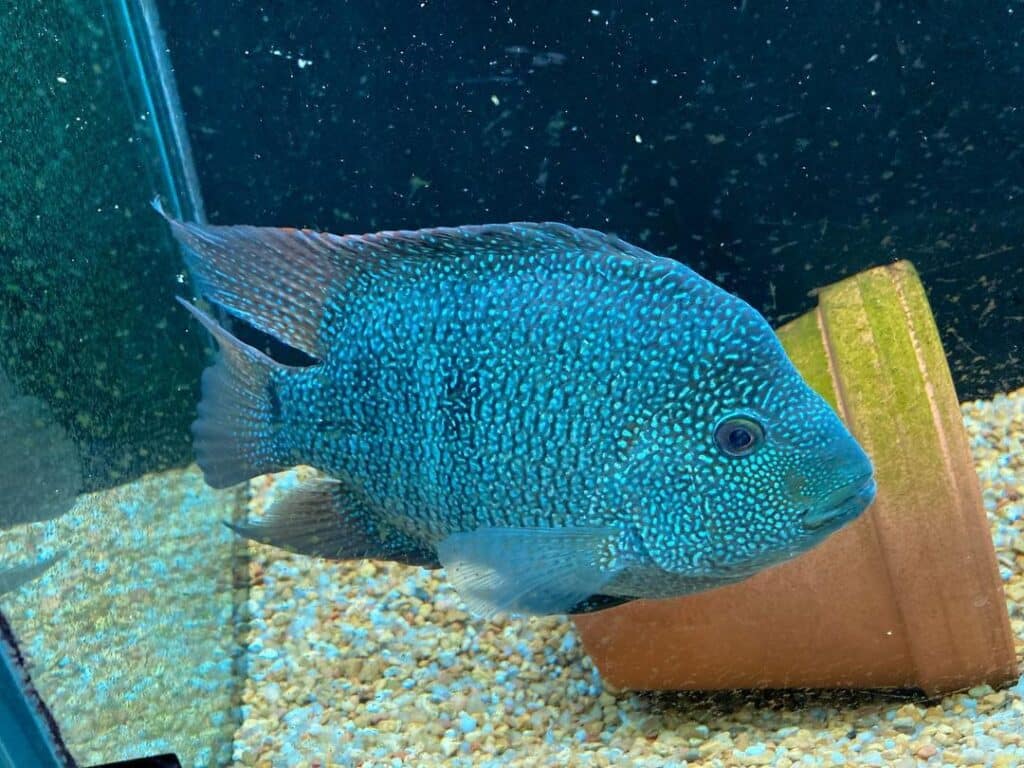Jaguar Cichlid
Scientific Classification
| Kingdom: | Animalia |
| Phylum: | Chordata |
| Class: | Actinopterygii |
| Order: | Perciformes |
| Family: | Cichlidae |
| Subfamily: | Cichlasomatinae |
| Genus: | Parachromis |
| Species: | P. Managuense |
| Binomial name: | Parachromis Managuensis |
Parachromis Managuensis, a big freshwater cichlid, indigenous to the Central regions of America, was discovered in Costa Rica in Honduras. Scientifically, this name has a reference to Lake Managua in the country of Nicaragua. It is from here that they obtained the holotype (Wiki: single physical example of an organism), which was a food-oriented fish. This Jaguar Cichlid was also observed in the pet trade; here it was called by many names such as Managua Cichlid, Jaguar Cichlid or Managuense Cichlid, Spotted Guapote, Jaguar Guapote, Aztec Cichlid, and Guapote Tigre. The length of an adult female Jaguar cichlid is 30 cm, whereas that of a male Jaguar Cichlid is 35 cm (14 in).

Habitat and range
You can see this fish along the Atlantic gradient of the Central regions of America, in Honduras from the Ulua River to River Matina running through Costa Rica. Quite different from the other fish found in the aquariums, the Jaguar Cichlid grows big enough to be a food for the humans In their indigenous habitat, the natives consume them for food, but, nevertheless, many consider them as a nuisance.
Description
The body of the Jaguar cichlid has a tendency of being lengthened and elliptically shaped. They are a few of the biggest cichlids that hail from the continent of South America and are capable of attaining a length of 24 inches (63cm) and weight of around 3½ pounds when found in nature. In aquariums, they are comparatively smaller in size and males will never exceed a length of around 16 inches (40 cm) and females around 14 inches (36 cm). However, this lengthwise measurement is adequate to retain the grade of this cichlid among the biggest cichlid in the aquariums. Normally they live up 15 years, however, by meticulous caring and proper safeguards, it is learnt that they survive rather somewhat for a longer period.
Breeding
Breeding these Jaguar cichlids is not a difficult task; it is done with less exertion and without any precise necessities. So long as you maintain the state of the water to a good level in quality, a couple of Jaguar cichlids willingly spawn in such conditions. In order to improve the chances of achieving a couple to breed, buy many agile and fit young ones (around 6 to 10) and raise these samples till they become mature sexually. Normally, you require a pair or two for the purpose of breeding. These cichlids significantly turn out violent and defensive. Separate the new breeding couple from the remaining fish.
Tank
While their growth in the wild may reach 2 feet and 3.5 pounds, luckily, when reared in tanks, they may attain a body length of only about 16 inches. On account of their big size and their partially violent nature, however; avoid housing them with comparatively small or less violent ones. In order to display their basic pale purple color use dark color of gravel.
Water condition
This variety of fish is an extreme predator and carnivores. They consume small size fish as well as most of the invertebrates. They like to reside in the turbid, ’Eutrophic” lakes where the waters are warm and exhausted of oxygen and are rich in organic nutrients, nitrates and phosphates that encourage proliferation plants like algae. The substrate in their native region is a sort of mud bottom; however, they are at the same time seen in other types of water bodies such as springs and ponds having bottoms of sand enclosed with the debris of the plants. They dwell in the lakes where the climatic conditions are tropical-like and have a preference of water of pH 7.0 to 8.7, with hardness of 10 to 15 dGH and temperature that range from 25 – 36 °C (77 – 97 °F). You can come across these Jaguar Cichlids in the waters below 3 – 10 meters (9.8 – 32.8 feet)
Nutrition
The water preferred by the Jaguar Cichlids is extremely Eutrophic (The free dictionary by Farlex: Rich in Mineral and organic nutrients that promote proliferation of algae and aquatic plants, resulting in a reduction of dissolved oxygen) with a lot of nourishment. It is more often seen where the base of the waters have debris, or are sandy or muddy. It performs well in muddy waters; however, you can particularly see them extensively in waters where there is depletion of oxygen.
Jaguar Cichlid Setup
The minimum size of the tank for a Jaguar Cichlid is 125 Gallon. The Jaguar Cichlid is too violent, and requires ample space in the tank having territorial lines and place for secluding themselves, when other fish are added. Decorate the aquarium with very strong material, fabricated with drift wood, big rocks and caves, and provide them with a substrate of big size gravel. Adding plants to the aquarium is discouraged, because there are chances of them destroying the plants easily. The habitat from where this Jaguar Cichlids come are muddy and murky, such an environment can be simulated by adding handfuls of arid leaves and a sack of aquarium safe peat along with the filter. It is mandatory to replace the leaves after a few weeks.

Having discovered a fondness for insects while pursuing her degree in Biology, Randi Jones was quite bugged to know that people usually dismissed these little creatures as “creepy-crawlies”.







